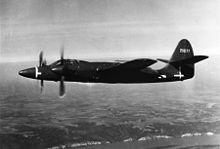McDonnell XP-67
| McDonnell XP-67 Moonbat | |
|---|---|

|
|
| Type: | Experimental airplane |
| Design country: | |
| Manufacturer: | |
| First flight: |
January 6, 1944 |
| Commissioning: |
- |
| Production time: |
- |
| Number of pieces: |
1 |
The McDonnell XP-67 Moonbat (English: moon bat ) was the prototype of a twin-engine interceptor .
history
In the early 1940s, the United States Army Air Corps wrote out a high-speed, high-altitude fighter that was supposed to intercept enemy bombers in long-range operations at high altitudes.
use
The prototype was ready on December 1, 1943 for initial taxiing tests, but on December 8, 1943, fire in both engine nacelles damaged the aircraft.
The prototype finally made its maiden flight on January 6, 1944, which ended after just six minutes due to engine problems.
On September 6, 1944, the right engine caught fire during a test flight. The test pilot EE Elliot made an emergency landing on Lambert Field , but could not prevent a total loss from the fire. With the loss of the only prototype, the program ended.
Technical specifications
| Parameter | Data |
|---|---|
| crew | 1 |
| length | 13.64 m (44 ft 9 in) |
| span | 16.76 m (55 ft) |
| height | 4.80 m (15 ft 9 in) |
| Wing area | 38.50 m² (414 ft²) |
| Empty mass | 8049 kg (17,745 lb) |
| Takeoff mass | 11,521 kg (25,400 lb) |
| Top speed | 650 km / h in 7600 m (352 knots, in 25,000 ft) |
| Service ceiling | 11,400 m (37,400 ft) |
| Range | 3,837 km |
| Engines | 2 × 12-cylinder V-engine Continental XIV-1430-17 / 19 1,350 PS (approx. 990 kW) |
See also
Web links
- XP-67 fighter. In: History. Boeing, accessed February 19, 2016 .
- U.S. Army Air Forces Air Technical Service Command: The XP-67 Moonbat. Air & Space / Smithsonian, 1944, accessed February 19, 2016 (English, video).
Individual evidence
- ^ A b Stephan Wilkinson: Too Hot to Handle: McDonnell XP-67 Moonbat. Air & Space / Smithsonian, January 2011, accessed February 19, 2016 .
